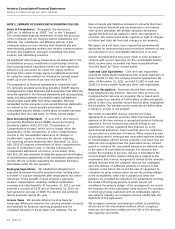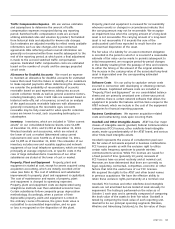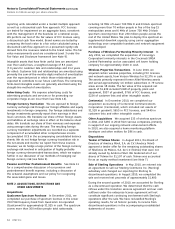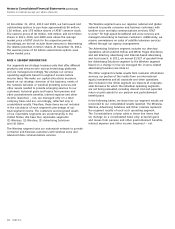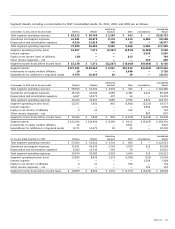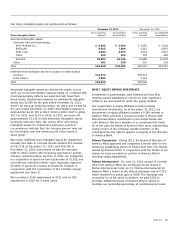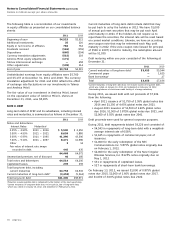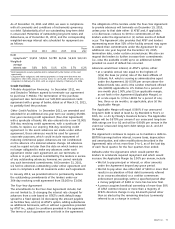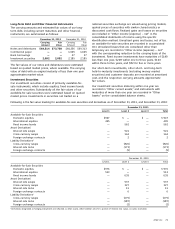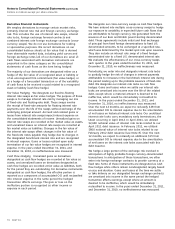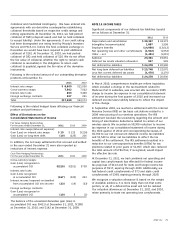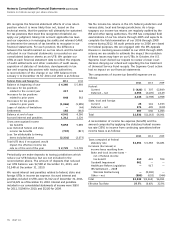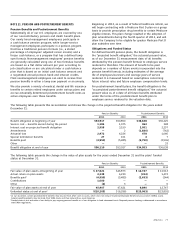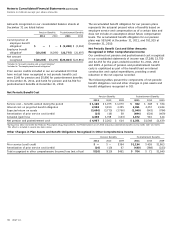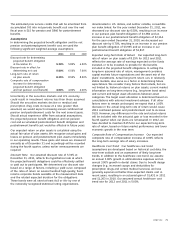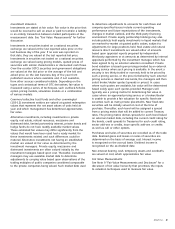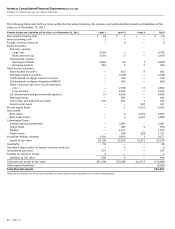AT&T Wireless 2011 Annual Report Download - page 74
Download and view the complete annual report
Please find page 74 of the 2011 AT&T Wireless annual report below. You can navigate through the pages in the report by either clicking on the pages listed below, or by using the keyword search tool below to find specific information within the annual report.
Notes to Consolidated Financial Statements (continued)
Dollars in millions except per share amounts
72 AT&T Inc.
The valuation methodologies described above may produce a
fair value calculation that may not be indicative of future net
realizable value or reflective of future fair values. We believe
our valuation methods are appropriate and consistent with
other market participants. The use of different methodologies
or assumptions to determine the fair value of certain financial
instruments could result in a different fair value measurement
at the reporting date. There have been no changes in the
methodologies used since December 31, 2010.
NOTE 9. FAIR VALUE MEASUREMENTS AND DISCLOSURE
The Fair Value Measurement and Disclosure framework provides a three-tiered fair value hierarchy that gives highest priority to
unadjusted quoted prices in active markets for identical assets or liabilities (Level 1 measurements) and the lowest priority to
unobservable inputs (Level 3 measurements). The three levels of the fair value hierarchy are described below:
LEVEL 1 Inputs to the valuation methodology are unadjusted quoted prices for identical assets or liabilities in active markets
that we have the ability to access.
LEVEL 2 Inputs to the valuation methodology include:
•Quotedpricesforsimilarassetsandliabilitiesinactivemarkets.
•Quotedpricesforidenticalorsimilarassetsorliabilitiesininactivemarkets.
•Inputsotherthanquotedmarketpricesthatareobservablefortheassetorliability.
•Inputsthatarederivedprincipallyfromorcorroboratedbyobservablemarketdatabycorrelationorothermeans.
LEVEL 3 Inputs to the valuation methodology are unobservable and significant to the fair value measurement.
•Fairvalueisoftenbasedondevelopedmodelsinwhichtherearefew,ifany,externalobservations.
•Materialbreachesofrepresentationsorwarrantiesinthe
agreement.
•Wefailtocomplywiththenegativepledgeordebt-to-
EBITDA ratio covenants under the Agreement.
•Wefailtocomplywithothercovenantsunderthe
Agreement for a specified period after notice.
•Wefailtomakecertainminimumfundingpayments
under Employee Retirement Income Security Act of 1974,
as amended (ERISA).
•Ourbankruptcyorinsolvency.
364-day Agreement
The obligations of the lenders to provide advances will
terminate on December 17, 2012, unless prior to that date
either: (i) we reduce to $0 the commitments of the lenders,
or (ii) certain events of default occur. We and lenders
representing more than 50% of the facility amount may
agree to extend their commitments for an additional
364-day period beyond the December 17, 2012, termination
date, under certain circumstances. We also can convert all
or part of outstanding advances under the 364-day
Agreement into term loan(s) maturing no later than the
first anniversary of the termination date, under certain
circumstances.
The asset’s or liability’s fair value measurement level within
the fair value hierarchy is based on the lowest level of any
input that is significant to the fair value measurement.
Valuation techniques used should maximize the use of
observable inputs and minimize the use of unobservable
inputs.
Advances would bear interest, at our option, either:
•atavariableannualrateequalto(1)thehighestof
(a) the base (or prime) rate of a designated bank,
(b) 0.50% per annum above the Federal funds rate,
and (c) the LIBOR for a period of one month plus 1.00%,
plus (2) an applicable margin as set forth in such
agreement (Applicable Margin); or
•atarateequalto:(i)LIBORforaperiodofone,two,three
or six months, as applicable, plus (ii) the Applicable Margin.
The Applicable Margin will equal 0.595% if our unsecured
long-term debt is rated at least A+ by Standard & Poor’s or
Fitch, Inc. or A1 by Moody’s Investors Service. The Applicable
Margin will be 0.710% per annum if our unsecured long-term
debt ratings are A or A2 and will be 0.950% per annum in the
event our unsecured long-term debt ratings are A- and A3
(or below).
The 364-day Agreement contains a negative pledge covenant
that is identical to the negative pledge in the Four-Year
Agreement. In the event we elect to convert any outstanding
advances to term loan(s), the debt-to-EBITDA financial ratio
covenant described above also would apply while such term
loan(s) were outstanding. The events of default described
applicable to the Four-Year Agreement also apply to the
364-day Agreement.


